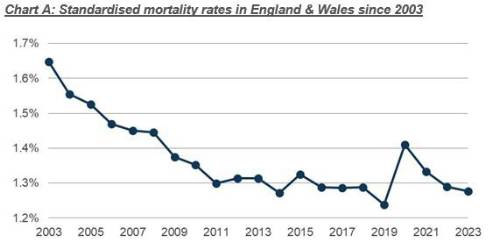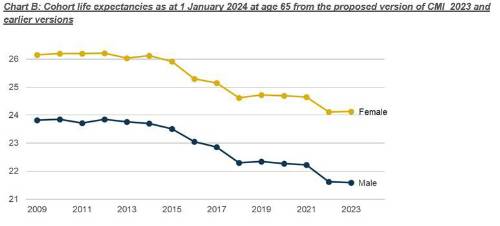If the proposal is adopted, CMI_2023 would produce cohort life expectancies at age 65 that are very similar to those in the previous version of the CMI model, CMI_2022 – around one week lower for males and one week higher for females.
The CMI Model is used by UK pension schemes and insurance companies which need to make assumptions about future mortality rates. While mortality experience in 2020 and 2021 will affect actuarial calculations, mortality in both of those years was exceptional and is unlikely to be indicative of future mortality. For this reason, the CMI places no weight on the data for 2020 and 2021 in the core version of the model, effectively ignoring those years.
More recent mortality has been less volatile and is more likely to be indicative of future mortality to some extent. Standardised mortality rates based on registered deaths in England & Wales in 2023 were similar to the 2015-2019 average and lower than in 2020, 2021 and 2022. Given that, the CMI proposes placing 10% weight on data for 2022 and 2023 when calibrating CMI_2023 while still placing no weight on data for 2020 and 2021.
As weights do not affect projections linearly, placing a 10% weight on data for 2022 and 2023 results in a projection that falls nearly half-way between a projection that places no weight on these years and one that gives them full weight.
Cobus Daneel, Chair, CMI Mortality Projections Committee, said: “While mortality since 2022 has been less volatile, mortality rates are still higher than what we expected prior to the pandemic which could plausibly be interpreted in a few ways: Were our pre-pandemic views too optimistic? Are there lingering short-term effects that will rapidly fade out as we revert to the pre-pandemic trend? Or did the pandemic have a fundamental impact on the longer-term trend?
“We have aimed to strike a balance between differing views with our proposals for CMI_2023 which would lead to similar life expectancies as in CMI_2022.
“We are conscious that the outlook for mortality remains uncertain and there is a range of reasonable projection methods and projected mortality rates. We are consulting on our proposals to gauge the views of users of the model. Given the uncertainty, we encourage and expect many users to modify the Model parameters or methods to reflect their own portfolios and their views of the impact of the pandemic.”
Detailed results
Chart A shows standardised mortality rates (which allow for consistent comparisons of mortality over time) in the general population of England & Wales from 2003 to 2023. Standardised mortality rates fell relatively rapidly in the period to 2011 and relatively slowly between 2011 and 2019. Mortality rose sharply in 2020 because of the COVID-19 pandemic. It subsequently fell and mortality in 2022 and 2023 was at a similar level to 2016 to 2018.

Chart B shows the progression of cohort life expectancy at age 65 in successive versions of the CMI Model. The figures for the proposed version of CMI_2023 are around two years lower than in the first version, CMI_2009.

The cohort life expectancies shown in Chart B for different versions of the CMI Model reflect a combination of mortality rates at the time and likely mortality improvements in later years. The fall in life expectancy since CMI_2009 is mainly due to changes in views of future mortality improvements. At the time of CMI_2009, mortality had been falling rapidly and this was generally expected to continue for some time, leading to relatively long cohort life expectancies. However, the outlook in CMI_2023 is for low mortality improvements in the short term. This leads to lower cohort life expectancies in CMI_2023 than in CMI_2009 even though mortality in 2023 was lower than in 2009.
|

